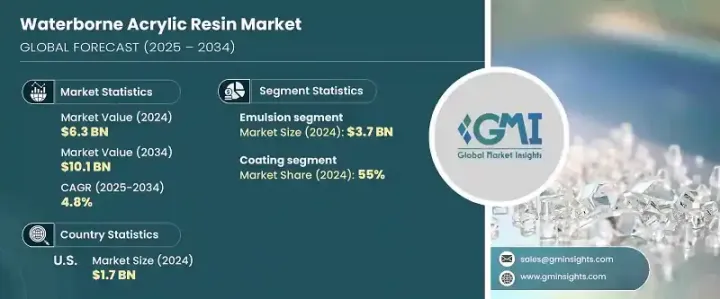PUBLISHER: Global Market Insights Inc. | PRODUCT CODE: 1685200

PUBLISHER: Global Market Insights Inc. | PRODUCT CODE: 1685200
Waterborne Acrylic Resin Market Opportunity, Growth Drivers, Industry Trend Analysis, and Forecast 2025 - 2034
The Global Waterborne Acrylic Resin Market reached USD 6.3 billion in 2024 and is expected to expand at a robust CAGR of 4.8% from 2025 to 2034. The surge in demand for eco-friendly coatings across a wide range of industries, such as automotive, construction, and packaging, is a major driver behind this growth. Waterborne acrylic resins are increasingly sought after for their low volatile organic compound (VOC) emissions, aligning with tightening environmental regulations and growing consumer demand for sustainable, green solutions. These resins are a go-to choice for manufacturers looking to meet environmental standards without compromising performance. With ongoing advancements in waterborne formulations, these resins offer enhanced stability, superior adhesion, and greater resistance to weathering compared to traditional solvent-based resins. This shift toward waterborne systems underscores the industry's commitment to sustainability, innovation, and efficiency in production.

By type, the waterborne acrylic resin market is segmented into solution, urethane-acrylic, emulsion, and other formulations. The emulsion-based resins segment generated USD 3.7 billion in 2024 and is projected to reach USD 5.9 billion by 2034. Known for their excellent water stability, emulsions simplify handling, storage, and transportation. Their outstanding film-forming properties deliver exceptional adhesion, long-lasting durability, and superior performance in demanding applications like paints, coatings, adhesives, and sealants. This versatility and ease of use make emulsion-based resins a popular choice across a range of sectors, driving their widespread adoption in the market.
| Market Scope | |
|---|---|
| Start Year | 2024 |
| Forecast Year | 2025-2034 |
| Start Value | $6.3 Billion |
| Forecast Value | $10.1 Billion |
| CAGR | 4.8% |
In terms of application, the coatings segment dominated the market, accounting for 55% of the share in 2024. The demand for waterborne acrylic resins in coatings continues to rise, primarily due to their exceptional adhesion and durability on diverse substrates. Their ability to form a fast-drying, resilient film enhances their appeal, especially in coatings for automotive, architectural, and industrial applications. Furthermore, the low VOC content ensures compliance with environmental regulations, particularly in areas with strict guidelines, further boosting the popularity of waterborne resins in the coatings sector.
In the United States, the waterborne acrylic resin market generated USD 1.7 billion in 2024, fueled by increasing environmental regulations such as the U.S. Environmental Protection Agency's (EPA) restrictions on VOCs in coatings and adhesives. The push for sustainability in the construction, automotive, and packaging industries has significantly raised demand for waterborne resins. Additionally, the growing adoption of green building certifications and sustainable construction practices has further accelerated the demand for eco-friendly architectural coatings. The U.S. market's emphasis on low-emission products and its strong regulatory environment continue to shape the future of the waterborne acrylic resin market.
Table of Contents
Chapter 1 Methodology & Scope
- 1.1 Market scope & definition
- 1.2 Base estimates & calculations
- 1.3 Forecast calculation
- 1.4 Data sources
- 1.4.1 Primary
- 1.4.2 Secondary
- 1.4.2.1 Paid sources
- 1.4.2.2 Public sources
Chapter 2 Executive Summary
- 2.1 Industry synopsis, 2021-2034
Chapter 3 Industry Insights
- 3.1 Industry ecosystem analysis
- 3.1.1 Factor affecting the value chain
- 3.1.2 Profit margin analysis
- 3.1.3 Disruptions
- 3.1.4 Future outlook
- 3.1.5 Manufacturers
- 3.1.6 Distributors
- 3.2 Supplier landscape
- 3.3 Profit margin analysis
- 3.4 Key news & initiatives
- 3.5 Regulatory landscape
- 3.6 Impact forces
- 3.6.1 Growth drivers
- 3.6.1.1 Environmental regulations and sustainability
- 3.6.1.2 Growing construction and automotive industries
- 3.6.1.3 Advancements in technology and product innovations
- 3.6.2 Industry pitfalls & challenges
- 3.6.2.1 Formulation challenges and performance
- 3.6.1 Growth drivers
- 3.7 Growth potential analysis
- 3.8 Porter’s analysis
- 3.9 PESTEL analysis
Chapter 4 Competitive Landscape, 2024
- 4.1 Introduction
- 4.2 Company market share analysis
- 4.3 Competitive positioning matrix
- 4.4 Strategic outlook matrix
Chapter 5 Market Size and Forecast, By Type, 2021-2034 (USD Billion) (Kilo Tons)
- 5.1 Key trends
- 5.2 Emulsion
- 5.3 Solution
- 5.4 Urethane-acrylic
- 5.5 Others
Chapter 6 Market Size and Forecast, By Application, 2021-2034 (USD Billion) (Kilo Tons)
- 6.1 Key trends
- 6.2 Coating
- 6.3 Adhesives
- 6.4 Textile finishes
- 6.5 Others
Chapter 7 Market Size and Forecast, By End Use, 2021-2034 (USD Billion) (Kilo Tons)
- 7.1 Key trends
- 7.2 Building & construction
- 7.3 Automotive
- 7.4 Furniture
- 7.5 packaging
- 7.6 Textile
- 7.7 Adhesives & sealants
- 7.8 Others
Chapter 8 Market Size and Forecast, By Region, 2021-2034 (USD Billion) (Kilo Tons)
- 8.1 Key trends
- 8.2 North America
- 8.2.1 U.S.
- 8.2.2 Canada
- 8.3 Europe
- 8.3.1 UK
- 8.3.2 Germany
- 8.3.3 France
- 8.3.4 Italy
- 8.3.5 Spain
- 8.3.6 Russia
- 8.4 Asia Pacific
- 8.4.1 China
- 8.4.2 India
- 8.4.3 Japan
- 8.4.4 South Korea
- 8.4.5 Australia
- 8.5 Latin America
- 8.5.1 Brazil
- 8.5.2 Mexico
- 8.6 MEA
- 8.6.1 South Africa
- 8.6.2 Saudi Arabia
- 8.6.3 UAE
Chapter 9 Company Profiles
- 9.1 AkzoNobel
- 9.2 Arkema
- 9.3 BASF
- 9.4 Dow Chemical
- 9.5 Eastman Chemical
- 9.6 Evonik Industries
- 9.7 Huntsman
- 9.8 Nippon Paint
- 9.9 Nippon Shokubai
- 9.10 PPG Industries
- 9.11 RPM International
- 9.12 Sherwin-Williams




